|
|
|
Sort Order |
|
|
|
Items / Page
|
|
|
|
|
|
|
| Srl | Item |
| 1 |
ID:
080874
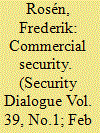

|
|
|
|
|
| Publication |
2008.
|
| Summary/Abstract |
Today, in what has been described as a re-emergence of privately organized extraterritorial force, the private military and security industry supplies the major military powers with a range of core services. This article asks how such a development came about, and why it has become politically uncomplicated to outsource such intimate state functions as the executive branches of foreign policy programmes. How did certain states arrive at a situation where it is unclear whether core military and security affairs are run by public or private agencies? The article answers these questions by presenting and commenting on general explanations as to why the private military industry has grown so much in post-invasion Iraq. It adds new perspectives to existing scholarly work by suggesting that the reappearance of private extraterritorial force could not have occurred on such a scale without a restructuring of neutrality in international relations. It is suggested that this change in neutrality might constitute the sine qua non of the re-emergence of private extraterritorial force.
|
|
|
|
|
|
|
|
|
|
|
|
|
|
|
|
| 2 |
ID:
080875
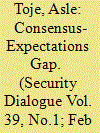

|
|
|
|
|
| Publication |
2008.
|
| Summary/Abstract |
By 2008, what is commonly known as the EU's `capability-expectations gap' has narrowed considerably. While the EU has made notable improvements in terms of its resource availability, as well as the instruments at its disposal, a gap between what the EU member-states are expected to do in the world and what they are actually able to agree upon persists. This article argues that the primary reason why the European Union is unable to deliver the foreign and security policies expected is a lack of decisionmaking procedures capable of overcoming dissent. Repeated attempts to surmount the drawbacks of consensus policymaking have only marginally improved the consistency and effectiveness of the Common Foreign and Security Policy (CFSP). These efforts are assessed by applying consensus as a `conceptual lens' through which to select and assess information. The real-world impact of the lack of cohesiveness, the capacity to make assertive collective decisions and stick to them, is illustrated by Europe's handling of the crisis in the Sudanese province of Darfur in the period 2003-08. The main finding of the article is that as long as the consensus-expectations gap exists, the EU is likely to remain a partial and inconsistent foreign policy actor.
|
|
|
|
|
|
|
|
|
|
|
|
|
|
|
|
| 3 |
ID:
080870
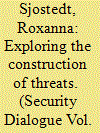

|
|
|
|
|
| Publication |
2008.
|
| Summary/Abstract |
In April 2006, Russian President Vladimir Putin publicly declared HIV/AIDS to be a threat to Russia's national security and proposed a guiding strategy to handle it. This move stood in sharp contrast to previous policies of the Russian government. Despite the fact that Russia has experienced one of the fastest growing rates of HIV/AIDS in the world since the turn of the millennium, the government's involvement had previously been minimal, not recognizing AIDS as a national security threat. The question then arises: when is a threat really threatening? This article contributes to the development of theories on threat-framing and security decisionmaking by suggesting an analytical framework that incorporates explanatory variables from different levels of analysis. The adoption of a broad theoretical position facilitates a comprehensive understanding of time and space variations in the securitization of issues. The article demonstrates that norms and identity constructions at the international and domestic levels, combined with their internalization by individual decisionmakers, can together explain Putin's move, and that these factors are of different importance at difference stages of the threat-construction process
|
|
|
|
|
|
|
|
|
|
|
|
|
|
|
|
| 4 |
ID:
080871
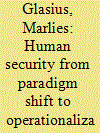

|
|
|
|
|
| Publication |
2008.
|
| Summary/Abstract |
This article shows how human security has functioned as both a paradigm-shifting and a bridging concept, with its most significant implications being, first, the shift from a focus on state security to one on human rights, and, second, the indivisibility of physical and material security. The article will argue that, despite attempts at narrowing and appropriation, human security has lost neither its radical edge nor its holistic character; however, the bulk of the literature on the subject is theoretical, and there has not been a serious enough effort to operationalize the term so as to enable a real shift in policymaking. The second half of the article is an attempt to operationalize human security while respecting its paradigm-shifting and holistic character. It discusses necessary connections with wider policy shifts before outlining ways in which current intelligence, development, military and `state-building' practices would have to be transformed to serve human security. Finally, a sketch is drawn of the ideal `human security worker' of the future and the contexts in which she might work.
|
|
|
|
|
|
|
|
|
|
|
|
|
|
|
|
| 5 |
ID:
080873
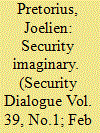

|
|
|
|
|
| Publication |
2008.
|
| Summary/Abstract |
This article proposes the notion of a security imaginary as a heuristic tool for exploring military isomorphism (the phenomenon that weapons and military strategies begin to look the same across the world) at a time when the US model of defence transformation is being adopted by an increasing number of countries. Built on a critical constructivist foundation, the security-imaginary approach is contrasted with rationalist and neo-institutionalist ways of explaining military diffusion and emulation. Merging cultural and constructivist themes, the article offers a `strong cultural' argument to explain why a country would emulate a foreign military model and how this model is constituted in and comes to constitute a society's security imaginary
|
|
|
|
|
|
|
|
|
|
|
|
|
|
|
|
| 6 |
ID:
080872


|
|
|
|
|
| Publication |
2008.
|
| Summary/Abstract |
This article presents unique material from in-depth interviews with 16 women in Rwanda who have testified in the gacaca, the village tribunals initiated to enhance reconciliation after the 1994 genocide. The aim of the interviews was to learn more about how testifying in such a public event as the gacaca affects psychological health. Do the women find the experience healing or retraumatizing? Are there other effects involved? There has been an assumption that testifying in truth and reconciliation commissions is a healing experience for survivors, and healing has been a central concept in the general reconciliation literature and in political rhetoric around truth commissions. However, the findings of the present study are alarming. Traumatization, ill-health, isolation, and insecurity dominate the lives of these testifying women. They are threatened and harassed before, during, and after giving testimony in the gacaca. The article provides a picture of the reconciliation process that we seldom see
|
|
|
|
|
|
|
|
|
|
|
|
|
|
|
|
|
|
|
|
|